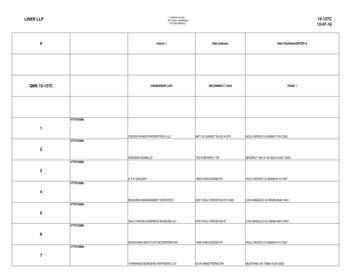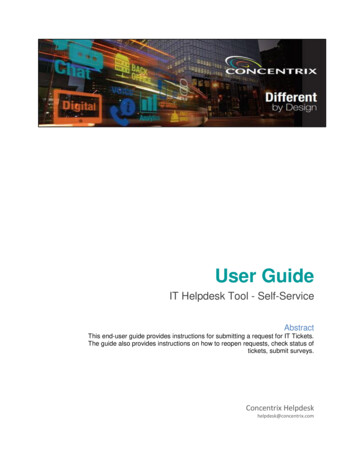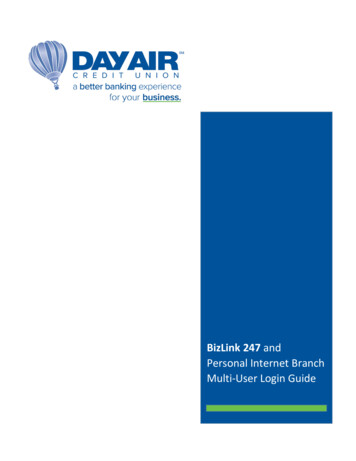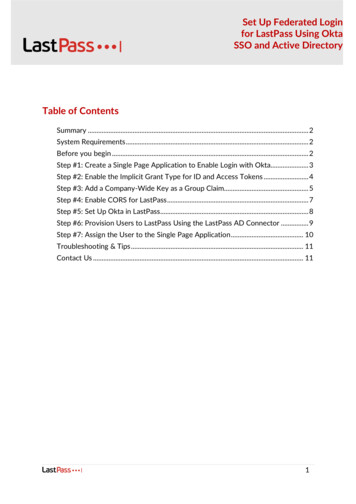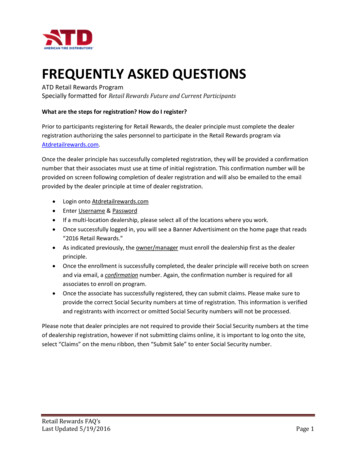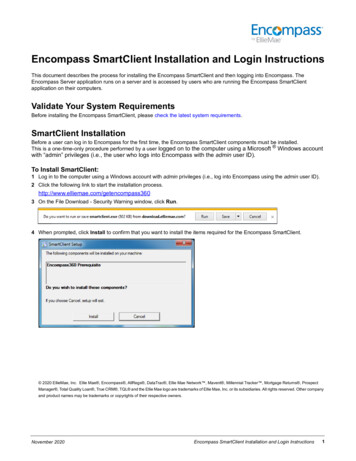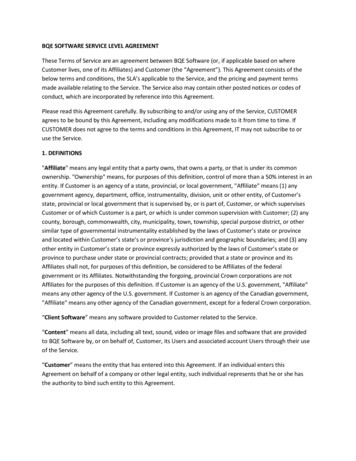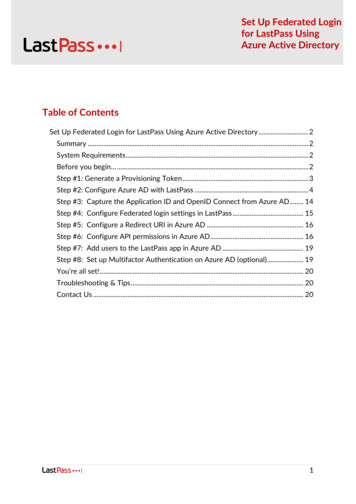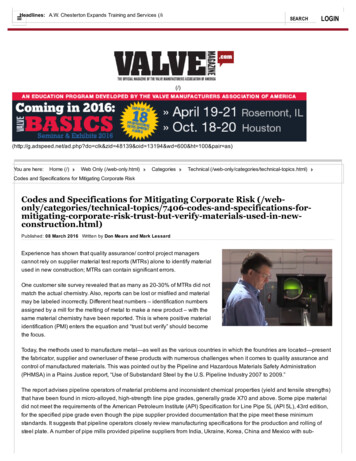
Transcription
Headlines: A.W. Chesterton Expands Training and Services (/industry headlines/industry headlines/valve manufacturing/7555 a w chesterton expand SEARCHLOGIN(/)(http://g.adspeed.net/ad.php?do clk&zid 48139&oid 13194&wd 600&ht 100&pair as)You are here:Home (/)Web Only (/web only.html)CategoriesTechnical (/web only/categories/technical topics.html)Codes and Specifications for Mitigating Corporate RiskCodes and Specifications for Mitigating Corporate Risk (/web only/categories/technical topics/7406 codes and specifications for mitigating corporate risk trust but verify materials used in new construction.html)Published: 08 March 2016 Written by Don Mears and Mark LessardExperience has shown that quality assurance/ control project managerscannot rely on supplier material test reports (MTRs) alone to identify materialused in new construction; MTRs can contain significant errors.One customer site survey revealed that as many as 20 30% of MTRs did notmatch the actual chemistry. Also, reports can be lost or misfiled and materialmay be labeled incorrectly. Different heat numbers – identification numbersassigned by a mill for the melting of metal to make a new product – with thesame material chemistry have been reported. This is where positive materialidentification (PMI) enters the equation and “trust but verify” should becomethe focus.Today, the methods used to manufacture metal—as well as the various countries in which the foundries are located—presentthe fabricator, supplier and owner/user of these products with numerous challenges when it comes to quality assurance andcontrol of manufactured materials. This was pointed out by the Pipeline and Hazardous Materials Safety Administration(PHMSA) in a Plains Justice report, “Use of Substandard Steel by the U.S. Pipeline Industry 2007 to 2009.”The report advises pipeline operators of material problems and inconsistent chemical properties (yield and tensile strengths)that have been found in micro alloyed, high strength line pipe grades, generally grade X70 and above. Some pipe materialdid not meet the requirements of the American Petroleum Institute (API) Specification for Line Pipe 5L (API 5L), 43rd edition,for the specified pipe grade even though the pipe supplier provided documentation that the pipe meet these minimumstandards. It suggests that pipeline operators closely review manufacturing specifications for the production and rolling ofsteel plate. A number of pipe mills provided pipeline suppliers from India, Ukraine, Korea, China and Mexico with sub
standard (API 5L X70 standard) pipe, specifically low and variable yield and tensile strength and chemical compositionproperties in high strength line pipe. Material verification reported low or no manganese, vanadium, niobium, molybdenumand titanium.This problem was caused by a combination of three factors: improper steel chemistry; improper rolling of steel plate; andimproper segregation of various grades of steel slabs at the steel mills.Metal manufacturing and processing requires precision at the elemental level, but with globalized trade in scrap metal, therise in counterfeit metals, and the possibility of inaccurate MTRs, all participants in the metal industry—suppliers, distributors,inspectors and industrial consumers—are at risk of alloy mix ups. Incorrect or out of specification alloy grades can lead topotentially catastrophic equipment failures.THE IMPORTANCE OF POSITIVE MATERIAL IDENTIFICATIONIn order to mitigate corporate risk, operations and construction personnel need to verify that they are using the correctmaterials. The material verification process compares the data in MTRs per line pipe and components, so that the heatnumber from the steel fabricator’s MTR is qualified and confirmed at the start of the project. Performing this level of verificationalso provides comprehensive records of material chemistry verification for a construction quality program.In the petrochemical industry, metal alloy parts and piping systemsconstructed of incorrect alloy grade or an alloy that doesn’t meetspecifications can experience accelerated corrosion that may result infailures and loss of containment of hazardous liquids and/or vapors.According to the API Recognized Practice 578, which specifically addressesmaterial verification, confirming that the actual composition of alloys in apiping system is consistent with the construction material specificationminimizes the potential for catastrophic release.Such actions are considered “recognized and generally accepted goodHandheld x ray technology identifies alloycomposition of critical metal piping and theircomponents in petrochemical plants. An inspectoruses a handheld XRF analyzer to check weldchemistry on an existing piping system as part of aretroactive PMI program in accordance with API RP578.engineering practice” (RAGAGEP). By definition, API RP 578 is:“Engineering, operation, or maintenance activities based on establishedcodes, standards, published technical reports or recommended practices(RP) or a similar document. RAGAGEP details generally approved ways toperform specific engineering, inspection or mechanical integrity activities,such as fabricating a vessel, inspecting a storage tank, or servicing a reliefvalve (See CCPS [Ref. 33]).”These actions also offer a cost/loss benefit ratio because they increase pipeline safety and reduce the chances that incorrectmaterial might enter the construction process and the finished product. They provide proof to regulators that the pipe, valve,components, fittings, welds, and the entire pressure containing envelope material’s MTR chemistry is verified as required byproject quality programs and owner requirements.UNDERSTANDING X RAY FLUORESCENCE TECHNOLOGYX ray fluorescence (XRF) analyzers play an important role in any industry where positive material identification (PMI) andelemental chemistry are critical.Using handheld XRF spectroscopy technology, nondestructive PMI testing of piping and components can be done in situwithout shutting down process equipment or sending material samples off site. Analyzers can instantly verify the quality andcomposition of metals at the point of delivery, on the production line, or at finished product inspection points. With lab qualityresults delivered in seconds rather than the days or weeks it can take for a traditional testing laboratory, production delays canbe avoided, safety compliance achieved, and customer expectations met.
Following the API codes and specifications as well as applying API RP578 PMI certification to your own fabrication process will improve andensure the quality and performance of the XRF operator.XRF spectroscopy technology, which was first used in the 1950s, analyzesthe composition of a sample by measuring the spectrum of the fluorescentx rays emitted by the different elements in a sample when it is bombardedwith high energy x rays. Each of the elements present in a sampleproduce a unique set of characteristic x rays that is a “fingerprint” for thatspecific element.Over the years, improvements in XRF technology have led to thedevelopment of the current handheld instruments that use x rays emittedfrom a miniaturized x ray tube.“When the operator pulls the trigger on an XRF analyzer, the x ray tube powers up and sends a primary x ray beam into thesample,” says Debbie Schatzlein, R&D staff scientist, portable analytical instruments for Thermo Fisher Scientific. “The primaryx ray beam impinges the sample – in this case metal alloy then a spontaneous process occurs at the atomic level releasingenergy in the form of fluorescent x rays,” she continues.These fluorescent x rays are measured by the detector, which can both identify the element (x ray energy is specific forindividual elements) and quantify it (based on the intensity of those specific energies).“The calculated concentrations of the individual elements are also compared to an on board alloy library, so that theinstrument not only displays the concentration of elements but also immediately identifies the alloy as well,” Schatzlein adds.The newest developments in handheld XRF analyzer technology incorporate an x ray source, detector (silica drift detector, orSDD), digital signal processor (DSP), central processing unit (CPU), and a data storage device.The x ray energy emitted from the sample – from 1.25kiloelectronvolt (keV) up to 50 keV – enters thedetector, which registers the individual x ray eventsand sends electronic pulses to the DSP. The DSPcollects and digitizes the x ray events occurring overtime, and sends the resulting spectral data to the mainCPU for processing.Using various spectral processing algorithms, the CPUmathematically analyzes the spectral data to producea detailed composition analysis. For metal alloy samples, the resulting data is then compared against an internal alloy libraryof minimum/maximum specifications to determine an alloy grade (or other designation) for the tested material. Thecomposition data and any resulting grade identification is then displayed on the instrument screen and stored in memory.The technology is capable of simultaneously identifying 30 of the most common elements, and can detect elements as light asmagnesium (atomic no. 12) to those as heavy as uranium (atomic no. 92).CONCLUSIONThere are not always shortcuts to verifying material chemistry, but breakthroughs in technology have made the process moreefficient for QA/QC project managers. The most critical steps for verifying material chemistry include:“Trust but verify” MTRs by checking the material chemistry with x ray fluorescence (XRF) technology on all valves, pipes,components, etc. before they are manufactured or installed in the field.
Compare the MTRs per line pipe and components to confirm the heat number for the mill’s MTR (random per heatnumber).Provide complete records of material chemistry verification for construction quality program and operations.Verify correct materials to mitigate corporate risk.Improve and ensure the quality and performance of the XRF operator by applying the API 578 PMI certification torequirements.Consider what the cost/loss benefit ratio would be because of increased pipeline safety and reduced chance of incorrectmaterial entering the construction process or finished product.Provide proof to regulators that pipe MTR chemistry is being verified as required by project quality programs and ownerrequirements.Maintaining this disciplined approach through a PMI program can help reduce risk and increase productivity – both criticalcomponents to a company’s overall success.Author InformationDon Mears (mailto:Don@ATC578.com) is an API certified training provider for Analytical Training Consultants, author of theAPI 578 PMI Certification Course and an oil & gas consultant. Mark Lessard (mailto:mark.lessard@thermofisher.com) ismarket development manager, portable analytical instruments for Thermo Fisher eid).Photos courtesy Thermo Fisher Scientific.BONUS: PIPELINE NETWORKS IN THE UNITED STATESPMI of piping material is an integral component to maintaining the structural integrity of oil and gas pipelines, and XRFtechnology allows operators to meet various challenges, as well as the newest recommended practice from the API.More than 190,000 miles of liquid petroleum pipelines traverse the United States. They connect producing areas to refineriesand chemical plants while delivering the products American consumers and businesses need. Pipelines are safe, efficientand, because most are buried, largely unseen. They move crude oil from oil fields on land and offshore to refineries, where itis turned into fuels and other products, then from the refineries to terminals where fuels are trucked to retail outlets. Pipelinesoperate 24 hours a day, seven days a week.Natural gas is delivered directly to homes and businesses through local distribution lines from local distribution companies.Large distribution lines, called mains, move the gas close to cities. These main lines, along with the much smaller servicelines that travel to homes and businesses, account for the vast majority of the nation’s 2.4 million miles of undergroundpipeline system.The focus on testing and verifying piping material as it relates to pipeline safety, specifically in vintage pipelines andcomponents, is a priority for API. XRF technology can play a critical role as pipeline operators adhere to the newest standard –API RP 1173 – which was rolled out in July 2015 as a joint endeavor by the Department of Transportation (DOT) Pipeline andHazardous Materials Safety Administration (PHMSA), NTSB, PHMSA and other entities.
ement(https://g.adspeed.net/ad.php?do clk&zid 57068&wd 300&ht 250&pair as)VIDEOVMA Members: Best in the WorldLATEST POSTPOPULARLINKSEVENTSFood and Beverage Sales Strongest in Four Years (/industry headlines/industry headlines/end user news/7557 food and beverage sales strongest in four years.html)Post: 05 May 2016
Factory Orders in the U.S. Increased in March (/industry headlines/industry headlines/manufacturing the economy/7556 factory orders in the u s increased in march.html)Post: 05 May 2016A.W. Chesterton Expands Training and Services Facility (/industry headlines/industry headlines/valve manufacturing/7555 a w chesterton expands training and services facility.html)Post: 05 May 2016G7 Countries Vow to Support Energy Investments (/industry headlines/industry headlines/end user news/7554 g7 countries vow to support energy investments.html)Post: 04 May 2016New Study Shows Demand for Natural Gas Will Grow (/industry headlines/industry headlines/end user news/7553 new study NEW PRODUCTS(/products/product (/products/product categories/pressure categories/control relief devices/7542 valves controls/7541 emerson wirelessly asco brass and monitored storage stainless steel spool (/products/product tank safety valves.html)A
By definition, API RP 578 is: “Engineering, operation, or maintenance activities based on established codes, standards, published technical reports or recommended practices (RP) or a similar document. RAGAGEP details generally approved ways to perform specific engineering, inspection or mechanical integrity activities, such as fabricating a vessel, inspecting a storage tank, or servicing a .
